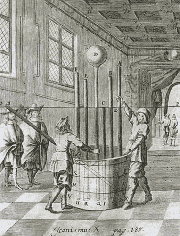Institute and Museum of History of Science, Florence, ITALY
 The historical experiments |
|
|
The extremely famous experiment of argento vivo (mercury), was performed by Torricelli in the Spring of 1644 in Florence. Torricelli filled a glass tube, open at one end, with mercury. Then, closing off the open end with a finger, he tipped the tube upside down and lowered it into a basin containing more mercury. He observed that the column of mercury only descended partially, stopping at a height of around 76 cm. Torricelli was convinced that the space created by the descent of the mercury in the tube was empty, and that what held up the column of mercury depended on the pressure that the air exerted on the mercury in the basin. In a letter to Michelangelo Ricci, 11th June, 1644, Torricelli declared that his experiment proved two fundamental concepts: that nature did not abhor the void, and that the air had weight. The results of the mercury experiment opened a period of revolutionary transformations and forced a fresh look at a doctrine which had been in force for centuries..
|
